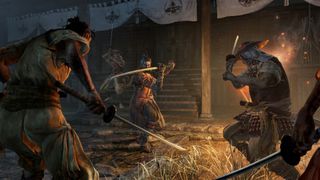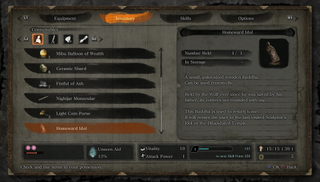Sekiro's brutal difficulty demands you relearn how to play a Souls game
Sekiro is all about aggression in combat, but we're happy to report From Software's enigmatic storytelling is still intact.
If you are one of the many people in the Miyazaki cult who were suspicious of the studio's pivot away from the grimdark fantasies of Dark Souls and the hallucinogenic horrors of Bloodborne, this should be good news. You will not collect souls or blood echoes, nor will you dump those resources into opaque leveling thresholds, or risk bankruptcy when a ghoulie cuts you down a stone's throw from the bonfire. But you will still die.
The Chain Ogre is a red-eyed, bearded giant whose moveset takes cues from Macho Man Randy Savage
In Sekiro, you take control of a shinobi in debt to a youthful liege, and the progression system unfurls in a distinctly non-RPG way—more like Japanese character action games. There's a long, interconnected skill tree, one that reminds me of Nioh or God of War, where you'll progressively add new abilities and maneuvers to your arsenal. And you can resurrect yourself once or twice after death, essentially giving you a mulligan in some of the game's toughest encounters.
Sekiro's linearity and revival mechanic caused some unrest in the SoulsBorne community. Had From Software gone soft? I mean, a Miyazaki game without constant corpse-runs? How could this be? Well, after two hours with Sekiro, and approximately one trillion deaths on a mini-boss called the "Chained Ogre," let me be the man to put those fears to bed.
The Chained Ogre can go to hell. You will meet him in the first chapter after the prologue, and he will gatekeep the hell out of you just like Bloodborne's Father Gascoigne and Dark Souls' Capra Demon once did. The Chain Ogre is a red-eyed, bearded giant plucked directly from the torrential battle scenes of medieval Japanese art. His moveset, however, takes cues from Macho Man Randy Savage. Massive elbow-drops, big boots, diving tackles. I'm surprised he never hit me with a piledriver. The ogre is deceptively quick for his size, demanding lightning reflexes to get out of his range. One hit drains about half your lifebar, and if you get caught in one of his bigger moves, you're almost certainly dead.
It was there, as the Ogre was driving my head into the dirt again and again and again, that the central tension of Sekiro became clear. The reason that this game doesn't saddle you with an extreme death penalty, and instead buffers your mortality with that resurrection ability, is because the protagonist is extremely fragile. You simply can't take that many hits without keeling over, and you won't be able to rely on kindled bonfires or blood vial farming either. The Healing Gourd, Sekiro's Estus Flask stand-in, came with exactly one charge. Why has From Software given us some more leeway around death? Simple: From Software expects us to die more than we ever have before.
In 2015 I marveled at Bloodborne's faster, more aggressive combat, compared to what From had established with the Souls games. It was all the proof I needed to know that director Hidetaka Miyazaki is a nerd for controls, and he greatly enjoys funneling his players into brand new mechanical schemes that can take years to master.
Sekiro has a distinct feel that sets it apart from both Bloodborne and Dark Souls. Gone are the stamina bar and the lengthy wind-ups between attacks. The shinobi is deadly; equipped with one-hit-kill stealth attacks, a grappling hook that immediately takes you out of harm's way, and a clockwork prosthetic arm that you can outfit with flamethrowers, a shield-destroying axe, or a few quicksilver shurikens. All of those attacks can be deployed extremely quickly. You don't need to duck away to recharge your attack animations. The majority of every duel you have in Sekiro will be in ultra-close quarters.
The biggest gaming news, reviews and hardware deals
Keep up to date with the most important stories and the best deals, as picked by the PC Gamer team.

For the first time in a decade of From Software action games, you're encouraged to attack directly into the defenses of the enemies you face, because a ton of your damage opportunity is going to come from guard breaks (or in Sekiro's parlance, "posture breaks"). Every time you face off with an enemy, a meter on the screen will tell you how close you are to breaking through their resolute swordsman stance, opening them up for a devastating killing blow. Stay off of them for too long, and their posture bar will refill, bringing you back to ground zero. You'll be monitoring the same dynamic on your own end as well. Take too many hits into your guard, and you're a sitting duck.
Sekiro also gives you a parry, which works like a faster version of what you had in Dark Souls. A well-timed parry followed by an immediate attack can do significant damage to an enemy's guard. Everything in the game appears to be blockable, save for a few specific attacks that are marked with a scarlet, flashing Japanese character for "DANGER." In those moments you pivot to a dodge, or a roll, or a jump. Oh yeah, you can jump in this game: a full-on, Neo-from-The-Matrix jump. It's the most mobility From has ever offered, which should push the skill-cap to places I will never reach.
With the two hours I got, I felt like I was barely scratching the surface of what optimal combat should look like in Sekiro. The rhythm is extremely fast, and I suspect that, like Bloodborne or even last year's God of War, it's gonna take a couple of sessions to fully understand what the game is asking of me. The thing that turned the tide in my struggle with the Chained Ogre was getting more hawkish and aggressive with my attacks. I had to dictate the pace. The sword-and-board patience of Lordran has no place here and only delays an embarrassing death.
Souls still burn
If you're a fan of those quiet moments, where weirdos in a fallen realm regale you with curious, elliptical dialogue, they've got your back.
The last thing that stuck out to me was the Sekiro lore. From Software narratives are typically abstruse beasts, and I greatly look forward to the VaataVidya video two months after Sekiro's release that converts all of the oblique cutscenes into a cohesive storyline. However, the From rep who beamed into our demo from Japan did have some interesting things to say about the story that I want to repeat here.
There was some concern that since the developer is making a game that's entrenched in history—the end of the Sengoku Period in Japan, specifically—it might lose some of the eldritch sense of scale that From games tend to muster. The narrative in Sekiro is going to be more personal and character-focused, but the From developer made clear that the deliberate enigma of their storytelling—the combing over for clues in the item descriptions, the deeply hidden easter eggs summoned up from appearing at a certain door, at a certain part of the game—will all be in place. The company seems to regard that as a crucial part of its tradition.
If you love these games for their one-of-a-kind attention to detail, and the flourishes that maybe one percent of the player-base might notice, then do not fret. As someone who first fell in love with Dark Souls after I realized I could curl up like an egg and return to the Undead Asylum, this was a relief.

While I didn't uncover any of those secrets myself, I can tell you that there is a hub similar to Firelink Shrine where characters you've encountered over the course of the game will make their home. (You also will need to periodically return to the hub to add attachments to your prosthetic arm, directly from the crusty old doctor who outfitted you with the device in the first place.) So if you're a fan of those quiet moments, where weirdos in a fallen realm regale you with curious, elliptical dialogue, they've got your back. Even better, From may have snuck in one brilliant bit of Chrono Trigger-inspired non-linearity.
In the climax of the prologue, you fight a rival samurai who steals away your child liege, and cuts off your arm for good measure. But that fight doesn't happen in a cutscene. Instead, you're put in a genuine combat encounter with the samurai that feels like any other boss in the game. I got stomped. You're supposed to get stomped—not only are you completely unfamiliar with the combat system at that point, but losing your arm and having the liege kidnapped is the impetus for the rest of the game. And yet... it felt like you could probably win if you really knew what you were doing.
The Activision rep stayed mum when I asked him about it. It'd be too much of a spoiler if he told me one of the main antagonists of the game could be killed in the first 15 minutes. But in the week since I played Sekiro, that's the memory I keep returning to. From Software loves to pull the rug out from under us: Stumbling into those high-level skeletons behind Firelink, or gaining enough Insight to see Yharnam for what it really is. The studio has a way of making worlds that are dense with strange, one-of-a-kind ideas. There's no doubt in my mind that the early game showdown with the samurai is just the tip of the iceberg. Sekiro's number one priority is to surprise you. In other words, it's a From game.

Luke Winkie is a freelance journalist and contributor to many publications, including PC Gamer, The New York Times, Gawker, Slate, and Mel Magazine. In between bouts of writing about Hearthstone, World of Warcraft and Twitch culture here on PC Gamer, Luke also publishes the newsletter On Posting. As a self-described "chronic poster," Luke has "spent hours deep-scrolling through surreptitious Likes tabs to uncover the root of intra-publication beef and broken down quote-tweet animosity like it’s Super Bowl tape." When he graduated from journalism school, he had no idea how bad it was going to get.
Most Popular

